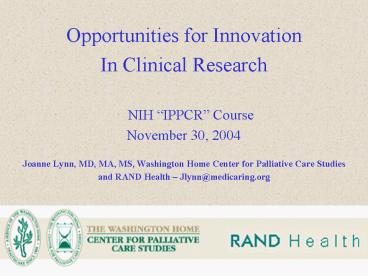Opportunities for Innovation PowerPoint PPT Presentation
1 / 25
Title: Opportunities for Innovation
1
- Opportunities for Innovation
- In Clinical Research
- NIH IPPCR Course
- November 30, 2004
- Joanne Lynn, MD, MA, MS, Washington Home Center
for Palliative Care Studies - and RAND Health Jlynn_at_medicaring.org
2
- How Americans Die A Century of Change
-
1900 2000 - Age at death 46 years 78 years
- Top Causes Infection Cancer
- Accident Organ system
failure - Childbirth Stroke/Dementia
- Disability Not much 2-4 yrs before
death - Financing Private,
Public and substantial- modest 83 in
Medicare ½ of women die in
Medicaid
3
What is the likelihood of survival on the days
just before dying?
1.0
0.8
Congestive heartfailure
0.6
Median 2-month Survival Estimate
0.4
Lung cancer
0.2
0.0
7
6
5
4
3
2
1
Medians of Predictions Estimated from Data on
These Days before Death
4
Median Prognosis by Day Before Death for Lung
Cancer and CHF, in SUPPORT
Median 2-month Survival Estimate
Days before Death
5
Severity of Illness, not Prognosis
- Prognosis often uncertain, right up to the end of
life - Median patient with serious chronic heart failure
has 50-50 chance to live 6 months on the day
before death (from SUPPORT, for both model and
physician estimate) - Severity of patient condition dictates needs
- Most patients need both disease-modifying
treatments and help to live well with fatal
disease
6
Estimate of lifespan distribution of costs
7
Traditional Organization of Treatment
Possibilities
Settings
Diseases
8
Health Status of the Population(a conceptual
model)
Chronic Illness consistent with usual role
need acute and preventive care
Healthy Need acute and preventive care
Chronic, progressive, eventually fatal
illness Need variety of services and
priorities 1-2 lt65 yo, 3-5 gt65 yo
9
Divisions by Health Status, in the Population and
Among Persons with Eventually Fatal Chronic
Illness
Chronic, consistent with usual role
A
Healthy
B
Chronic, progressive, eventually fatal illness
C
10
- Cancer Trajectory, Diagnosis to Death
High
Cancer
Possible hospice enrollment
Function
Death
Low
-- Often a few years, but decline usually lt 2
months
Time
Onset of incurable cancer
11
- Organ System Failure Trajectory
High
(mostly heart and lung failure)
Function
Death
Low
2-5 years, but death usually seems sudden
Begin to use hospital often, self-care becomes
difficult
Time
12
- Dementia/Frailty Trajectory
High
Function
Low
Death
Time
Quite variable - up to 6-8 years
Onset could be deficits in ADL, speech, ambulation
13
Old Concept
death
Treatment
Aggressive Care
Palliative Care
Time
14
Better Concept
death
Disease-modifying curative
Treatment
Symptom management palliative
Time
Bereavement
15
Opportunities for Innovative Research?
- Describe the trajectories, test for crossover
- Model the optimum services, estimate cost
- Discern payment characteristics N for stable
estimate, outliers, adverse incentives - Assess psychological aspects of reform
- Develop methods to monitor effects on lifespan
- ETC.
16
Treatment
17
Examples of Aims
- Within six months, reduce resident transfers from
our nursing home to the hospital in the last week
of life to less than 20 of all who will die - To decrease the number of patients with advanced
disease transferred from home hospice or nursing
home to the acute care setting at end-of-life by
50 by May
Treatment
18
(No Transcript)
19
Percent of Patients Who Can Verbalize
Self-Management Techniques Tucson Medical
Center (n 32)
99
20
Percent of Exacerbations Requiring Emergency Room
CareHospice of Winston-Salem (N13 to 24)
21
Opportunities for Innovative Research?
- Symptom research, implementation
- Caregiver support paid and family
- Advance care planning to do and IT
- Hospice services, limits, substitutes
- CQI reliability, validity, generalizability
- Strategies for planned change generally
- Measures of quality nearing death
22
US Hospitalist PhysiciansViews on Terminal
Sedation
Lynn, Goldstein, Annals Int Med, May 20,2003
23
Ideas to Alter the Status Quo
- Serious chronic illness makes patients too sick
for hospitalization. - Ordinary patterns of care are appropriately
classified as errors and threats to safety. - High-cost treatments and caregiver shortage will
create opportunities for disaster or for creative
responses. - Choice is important, but less important than
having at least one reliable service package. - The most scarce element in reform is the WILL to
start. - We suffer from lack of stories
24
Resources
- For the public-
- Web www.growthhouse.org
- Book Handbook for Mortals
- For quality improvement
- Book Improving Care for the End of Life
- Web www.medicaring.org
- For Policy
- Web www.abcd-caring.org
- Exchange - Am. for Better Care of the Dying
25
Orbis Terrarum, 1675 by Visscher

